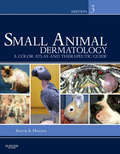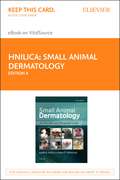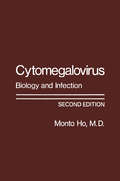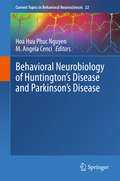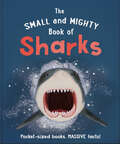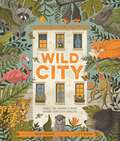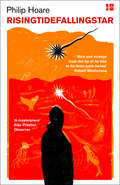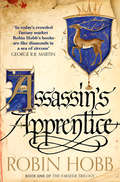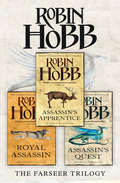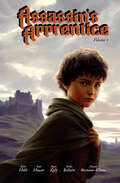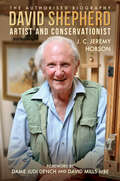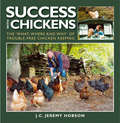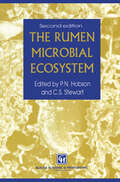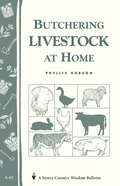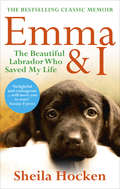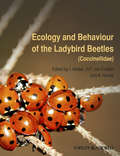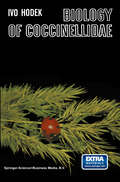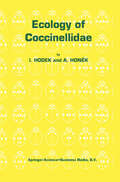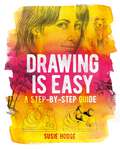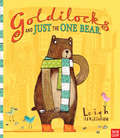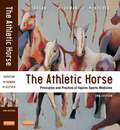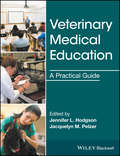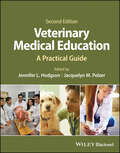- Table View
- List View
Small Animal Dermatology - E-Book: A Color Atlas and Therapeutic Guide
by Keith A. HnilicaDesigned with busy practitioners and students in mind, Small Animal Dermatology: A Color Atlas and Therapeutic Guide provides concise, thorough coverage of over 250 skin diseases affecting small animals. More than 1,000 high-quality images help to ensure accurate diagnoses, with coverage including clinical features, top differentials, treatment, and prognosis for each disorder. In this edition, author Keith A. Hnilica streamlines content for practical, everyday use in the clinic. The differential diagnosis chapter is updated for added clarity and easier use, and for quick access, chapters now list diseases based upon the frequency of their occurrence in the pet population.A user-friendly organization allows for quick and easy access to information on specific diseases.Vivid, full-color images facilitate accurate diagnosis of each disorder.A comprehensive drug appendix includes information about dosage, adverse reactions, indications, and contraindications.A new section on skin diseases of birds and exotic pets covers the management of rabbits, ferrets, hamsters, guinea pigs, gerbils, chinchillas, turtles, snakes, and lizards. Hundreds of new, full-color images clearly demonstrate the clinical appearance of skin lesions for accurate diagnosis and treatment.Expanded coverage includes multiple methods of developing a differential diagnosis list based on patterns, breed, lesion type, and lesion location.Coverage of the zoonotic potential of animal skin diseases includes information on preventing the spread of disease from animal to human.Content is streamlined to focus on the more common and likely to be seen clinical problems.A completely updated drug formulary outlines the most effective treatment of dermatological conditions.
Small Animal Dermatology - E-Book: A Color Atlas and Therapeutic Guide
by Keith A. Hnilica Adam P. PattersonStreamlined for practical, everyday use in the clinic, Small Animal Dermatology: A Color Atlas and Therapeutic Guide, 4th Edition provides concise, thorough information on more than 250 skin diseases affecting small animals. More than 1,400 high-quality images help to ensure accurate diagnoses, with coverage including recognizable clinical signs, top differentials, diagnostic tests, treatment recommendations, and prognosis for each disorder. The differential diagnosis chapter adds clarity to the difficult task busy students and practitioners face every day – identifying what dermatologic condition is causing a dog, cat, or exotic animal to suffer. Chapters list diseases based upon the frequency of their occurrence in the pet population, and detailed procedures include helpful illustrations of key techniques.Well-organized, concise, yet comprehensive, coverage of over 250 skin diseases in dogs, cats, birds, and exotic pets like rabbits, ferrets, hamsters, guinea pigs, gerbils, chinchillas, turtles, snakes, and lizards allows for quick and easy reference. Comprehensive drug appendices highlight information about dosage, adverse reactions, indications, and contraindications for antimicrobial, antiseborrheic, and antipruritic shampoo therapy, topical, otic, and systemic therapeutic drugs.Detailed procedures include helpful illustrations of key techniques. Thoroughly covers each disorder with recognizable clinical signs, top differentials, diagnostic tests, treatment recommendations, and prognoses.More than 1,450 vivid, full-color images in atlas format clearly demonstrate clinical appearance of skin lesions to facilitate accurate diagnosis and treatment. An atlas of before- and after-treatment images provides you with a compelling client communication tool to promote treatment acceptance and compliance. Emphasizes important information on the continuing emergence of zoonotic skin diseases in each chapter.
Cytomegalovirus: Biology and Infection
by Monto HoAlthough there are a number of excellent current reviews on one or another aspect of cytomegalovirus, the last comprehensive treatment of this subject was that of Krech et al. (197la). In view of the amazing advances in the virological, epidemiologic, and clinical knowledge of cytomegaloviruses, an up-to-date book is needed. Such a work should cover many areas of expertise and a voluminous technical literature. Each area might have been reviewed and analyzed by workers more expert than myself. However, I have embarked on the entire venture alone in order to attain unity and continuity in this book, characteristics that are not easily achieved in the more popular multiauthored works. I have tried to review the Iiterature and provide a critical summary for each area discussed. To do this, I provide as much of the primary data of the relevant works as needed and not just the qualitative conclusions. Inevitably, the flow of the narrative may be interrupted by dry facts and figures. However, such information is essential to make this a meaningful reference work. But for those not interested in such details, I have provided at what I hope are crucial points critiques and summaries. This book is not an exhaustive review of all the literature. This is probably no Ionger possible or even desirable. By selection, however, one runs the risk of having missed or ignored important papers. I am keenly aware of this, and I wish to apologize for such oversight, if that is possible.
Behavioral Neurobiology of Huntington's Disease and Parkinson's Disease (Current Topics in Behavioral Neurosciences #22)
by Hoa Huu Phuc Nguyen M. Angela CenciMotor dysfunction and cognitive impairment are major symptoms in both Huntington’s Disease (HD) and Parkinson’s Disease (PD). A breakthrough in HD research was the identification of the gene that causes this devastating monogenetic illness. Similarly, several genes were found to cause familial forms of PD. With their identification, a plethora of genetic animal models has been generated and has revolutionized the understanding of the pathobiology and pathophysiology of these disorders. The models allow us to study the earliest manifestations of the diseases behaviorally and neuropathologically and help us understand how they progress over time. Additionally, neurotoxic animal models are still of high interest to the PD field, as they are being used to study e.g. mitochondrial dysfunction in PD. This book focuses on animal models of both diseases and how they have helped and will continue to help understand the behavioral neurobiology in these disorders.
The Small and Mighty Book of Sharks: Pocket-sized books, massive facts! (The Small and Mighty Book of…)
by Ben HoareFilled with bite-size facts and amazing original illustrations, the Small and Mighty range is the ultimate pocket-sized collectible series for young readers who can't get enough of their favourite topic.In The Small and Mighty Book of Sharks, readers can get up close and personal with their favourite sharks. Discover a huge range of sharks, from the tiny Dwarf Lantern Shark to the enormous Whale Shark. Fascinating facts and info are nestled amongst vibrant, striking illustrations of these ferocious beasts. This pocket-sized book is the perfect companion to any shark fanatic!
Wild City: Meet the animals who share our city spaces
by Ben HoareTake an unforgettable tour around the world to meet the creatures that share our city spaces – from bears to bats, penguins to opossums – and learn about how they have adapted and thrived in this gorgeously illustrated gift book written by award-winning natural history journalist Ben Hoare.Wild City travels the globe, exploring how animals have adapted to live alongside humans, in busy cities including New York, Rio de Janeiro, Berlin, Stockholm, London, Alexandria, Singapore and Mumbai. Discover hawks by a world-famous shopping street, snakes slithering through city sewers, and penguins waiting patiently to cross the road. Feature spreads take a closer look at the animals, showing how some wander in plain sight while others hide away in our homes, and we meet wildlife heroes from around the world – ordinary people doing extraordinary things to make our wild neighbours feel welcome.Lyrical and factual text written by the award-winning Ben Hoare is perfectly complemented by Lucy Rose's stunning illustrations. The beautiful cityscapes are full of detail with something new to discover with every look.
RISINGTIDEFALLINGSTAR: In Search Of The Soul Of The Sea
by Philip HoareRich and strange from the tip of its title to its deep-sunk bones’ Robert Macfarlane From the author of Leviathan, or, The Whale, comes a composite portrait of the subtle, beautiful, inspired and demented ways in which we have come to terms with our watery planet.
Assassin’s Apprentice: Assassin's Apprentice; Royal Assassin; Assassin's Quest (The Farseer Trilogy #1)
by Robin Hobb‘Fantasy as it ought to be written’ George R.R. Martin
The Complete Farseer Trilogy: Assassin's Apprentice; Royal Assassin; Assassin's Quest
by Robin HobbThe complete Farseer Trilogy by international bestselling author Robin Hobb. ‘In today’s crowded fantasy market Robin Hobb’s books are like diamonds in a sea of zircons’ George R. R. Martin
Assassin’s Apprentice Volume 1: The Graphic Novel (The Farseer Trilogy #1)
by Robin Hobb Jody HouserThe first installment of Robin Hobb's New York Times bestselling fantasy epic, The Assassin's Apprentice (Farseer Trilogy), comes to life in comics form!
David Shepherd: Artist and Conservationist
by J. C. HobsonIn 1975, David Shepherd wrote The Man Who Loves Giants – an autobiography. Even though he was only forty-four, he had already achieved more than most could have in three lifetimes. In the intervening years, until his death in 2017, he painted a huge variety of subjects, founded the David Shepherd Wildlife Foundation, renovated and restored everything from steam engines to dolls’ houses, and appeared on both radio and television. ‘Being the extrovert I am,’ he once said, ‘I like things large and exciting … especially elephants …’ However, this enthusiasm wasn’t restricted to animals, it extended to his love and ownership of several full-sized steam engines, including locomotive number 92203, otherwise known as Black Prince. David’s friends ranged from showbiz celebrities to well-known sportsmen and women, and British and European royalty to internationally influential politicians and presidents. He was awarded the Order of the Golden Ark by Prince Bernhard of the Netherlands for his services to conservation in Zambia, and the Order of Distinguished Service, First Class, by President Kaunda. Her Majesty The Queen presented David with the OBE and CBE. David’s first gallery successes were not of the African wildlife for which he is now best known. London scenes, planes, boats and trains have long featured in his portfolio – as do English landscapes and bygone rural life. Since David’s autobiography, no book has dealt so comprehensively with his life, painting, and conservation work as this biography by J. C. Jeremy Hobson, professional author and David’s youngest son-in-law. With access to family archives and photographs, private diaries and reminiscences, this is a unique portrait of a remarkable man.
SUCCESS WITH CHICKENS: THE WHAT, WHERE AND WHY OF TROUBLE-FREE CHICKEN KEEPING
by JEREMY HOBSONChicken-keeping is an increasingly popular hobby as more and more people discover the benefits of raising chickens and supplying their own eggs. Written by an expert chickenkeeper of many years standing, the subjects covered include choice of breed, housing, feeding, breeding, showing and indeed all the many topics the new chicken keeper will want to understand. This practical guide incorporates much of the author s forty years of experience as a chicken keeper, as well as taking advantage of the knowledge and experience of other enthusiasts. Also included, either because of their relevance, or simply their ability to raise a wry smile, are several snippets taken from poultry books written during the first half of the twentieth century
The Rumen Microbial Ecosystem
by P. N. Hobson C. S. StewartThe Preface to the first edition of this book explained the reasons for the publication of a comprehensive text on the rumen and rumen microbes in 1988. The microbes of the ruminant's forestomach and those in related organs in other animals and birds provide the means by which herbivorous animals can digest and obtain nutriment from vegetation. In turn, humans have relied, and still do rely, on herbivores for much of their food, clothing and motive power. Herbivores also form the food of carnivorous animals and birds in the wild. The importance of the rumen microorganisms is thus apparent. But, while a knowledge of rumen organisms is not strictly neces sary for the normal, practical feeding of farm animals, in recent years there has been much more emphasis on increasing the productivity of domesti cated animals and in rearing farm animals on unusual feedstuffs. Here, a knowledge of the reactions of the rumen flora, and the limits to these reactions, can be invaluable. In addition, anaerobic rumen-type microor ganisms are found in the intestines of omnivores, including humans, and can be implicated in diseases of humans and animals. They are also found in soils and natural waters, where they playa part in causing pollution and also in reducing it, while the same organisms confined in artificial systems are essential for the purification of sewage and other polluting and toxic wastes.
Butchering Livestock at Home: Storey's Country Wisdom Bulletin A-65 (Storey Country Wisdom Bulletin)
by Phyllis HobsonThis introductory guide explains the basics of butchering your meat at home, from preparing your animals and equipment through to storing your meat. Covers rabbits, poultry, sheep, goats, veal calves, beef, and hogs and includes information on how to process and use organ meats, pelts and hides, feathers, bones and horns, and fat.
Emma and I: The Beautiful Labrador Who Saved My Life
by Sheila HockenAs a girl, Sheila never let her gradual descent into blindness prevent her from trying to do everything a sighted person could do. Then at 17, unable to see to find her way around the house she grew up in, she found herself dreading her future in an 'ever darkening vacuum'.But then the remarkable Emma enters her life, and Sheila begins a journey that brings her the independence, love and happiness she never dreamed possible.Emma and I is the moving and inspirational story of the unique bond between Sheila and her dog, and shows that, sometimes, miracles do happen.
Ecology and Behaviour of the Ladybird Beetles (Coccinellidae)
by I. Hodek A. Honek H. F. van EmdenLadybirds are probably the best known predators of aphids and coccids in the world, though this greatly underestimates the diversity of their biology. Maximising their impact on their prey is an important element in modern conservation biological control of indigenous natural enemies in contrast to the classical approach of releasing alien species. Ivo Hodek is one of the most internationally respected experts on coccinellids who has researched these insects for his entire career. He has now brought together 14 scientists of international standing to author 12 chapters, making this book the definitive treatment of coccinellid biology and ecology. This volume covers the rapid scientific developments of recent years in the understanding of coccinellid phylogeny, the semiochemicals influencing their behaviour and of molecular genetics. Recent insights in relation to intraguild predation and the assessment of the predatory impact of coccinellids are also covered. Other special features of the volume are the extensive references covering the literature from both East and West and a taxonomic glossary of the up-to-date nomenclature for species of coccinellids as well as of other organisms mentioned in the text. While aimed at researchers, university teachers and agricultural entomologists, the book is readable and appropriate for others who just have a liking for these interesting and attractive insects.
Biology of Coccinellidae
by Ivo HodekThis book provides the first monograph of Coccinellidae. Although the group finds inclusion both in Clausen's (1940) "Entomophagous Insects" and in Balduf's (1935) "Entomophagous Coleoptera", reference in these works is limited to three and twenty pages respectively. Moreover, the last thirty years since these books appeared have ~een a great deal of work on the group. The use of insecticides largely destroyed the early attempts at biological control and interest remained low for as long as insecticides appeared quite successfuL However, the problems of insecticides soon became apparent, and in the last decade there have been tremendous developments in biological control, particularly in eombin
Ecology and Behaviour of the Ladybird Beetles (Coccinellidae)
by Ivo Hodek A. Honek Helmut F. Van EmdenLadybirds are probably the best known predators of aphids and coccids in the world, though this greatly underestimates the diversity of their biology. Maximising their impact on their prey is an important element in modern conservation biological control of indigenous natural enemies in contrast to the classical approach of releasing alien species. Ivo Hodek is one of the most internationally respected experts on coccinellids who has researched these insects for his entire career. He has now brought together 14 scientists of international standing to author 12 chapters, making this book the definitive treatment of coccinellid biology and ecology. This volume covers the rapid scientific developments of recent years in the understanding of coccinellid phylogeny, the semiochemicals influencing their behaviour and of molecular genetics. Recent insights in relation to intraguild predation and the assessment of the predatory impact of coccinellids are also covered. Other special features of the volume are the extensive references covering the literature from both East and West and a taxonomic glossary of the up-to-date nomenclature for species of coccinellids as well as of other organisms mentioned in the text. While aimed at researchers, university teachers and agricultural entomologists, the book is readable and appropriate for others who just have a liking for these interesting and attractive insects.
Ecology of Coccinellidae (Series Entomologica #54)
by Ivo Hodek Alois HonekCoccinellids have been very actively studied in the course of the twenty three years since "Biology of Coccinellidae" was published. The great amount of new, and often very important findings have made the previous book outdated and a new synthesis is needed. No other monograph of similar focus and extent has appeared. Iablokoff Khnzorian's "Les Coccinelles" (1982), limited to the tribus Coccinellini, and Gor don's "The Coccinellidae of America North of Mexico" (1985) both concentrate on taxonomy. Majerus' beautiful "Ladybirds" (1994) deal specifically with British coc cinellids and address chiefly amateur naturalists. The focus and the title of the recent book are slightly different from the 1973 vol ume. If a satisfactory comprehensive review of important new findings is attempted, the book would grow too much, due also to References and Indexes. To keep the vol ume at a tolerable extent, the section on larval identification of Palaearctic species has been omitted; not much could be added to the previous version of that part, any way. However, we have kept Kovar's chapter on morphology and anatomy, because of its relation to feeding and other ecological aspects. The chapter on phylogeny was updated also by him. Our Polish friend, Piotr Ceryngier, who has recently specialised in parasites, updated perfectly the parts on parasites and pathogens in Chapter 8. We would be glad if their contribution is quoted by their names. It seems to us that the remarks, contained in the reprinted preface to the previous volume, remain pertinent today.
Drawing is Easy: A step-by-step guide
by Susie HodgeDrawing is easy - but you need to know the basics. Artist and writer Susie Hodge gets you drawing right away. With simple exercises to build your confidence, she quickly shows you how to grasp the fundamentals. Every exercise is made up of step-by-step instructions with clear, easy-to-follow illustrations. Line by line, you can see how it's all done and soon you will be creating your own fantastic artworks.Step-by-step projects include: • A glass full of water• A forest on a Spring day• Faces and their proportions• Drawing draped and crumpled fabricsFor anyone who's ever wanted to try their hand at drawing, but hasn't had the confidence, this thorough guide will provide you with the groundwork to get you sketching what you see.
Goldilocks and Just the One Bear
by Leigh HodgkinsonMany years have passed since Goldilocks caused chaos at the Bears' house in the woods, but what happens when Little Bear as was wanders out of his fairytale and into the big city where Goldilocks now lives? Awarding-winning artist and animator Leigh Hodgkinson is the creator of this funny and clever fractured fairytale based on the familiar story of Goldilocks and the Three Bears. Goldilocks is now grown up with a family and a rather smart apartment, so how will she react to coming home and finding that a very lost bear has been scoffing porridge, breaking chairs and sleeping in beds? Will she be cross, or is finally time to make amends?
The Athletic Horse - E-Book: Principles and Practice of Equine Sports Medicine
by David R. Hodgson Catherine M. McGowan Kenneth McKeeverShowing how to maximize performance in horses, The Athletic Horse: Principles and Practice of Equine Sports Medicine, 2nd Edition describes sports training regimens and how to reduce musculoskeletal injuries. Practical coverage addresses the anatomical and physiological basis of equine exercise and performance, centering on evaluation, imaging, pharmacology, and training recommendations for sports such as racing and show jumping. Now in full color, this edition includes new rehabilitation techniques, the latest imaging techniques, and the best methods for equine transportation. Written by expert educators Dr. David Hodgson, Dr. Catherine McGowan, and Dr. Kenneth McKeever, with a panel of highly qualified contributing authors.Expert international contributors provide cutting-edge equine information from the top countries in performance-horse research: the U.S., Australia, U.K., South Africa, and Canada.The latest nutritional guidelines maximize the performance of the equine athlete.Extensive reference lists at the end of each chapter provide up-to-date resources for further research and study. NEW full-color photographs depict external clinical signs, allowing more accurate clinical recognition.NEW and improved imaging techniques maximize your ability to assess equine performance.UPDATED drug information is presented as it applies to treatment and to new regulations for drug use in the equine athlete.NEW advances in methods of transporting equine athletes ensure that the amount of stress on the athlete is kept to a minimum.NEW rehabilitation techniques help to prepare the equine athlete for a return to the job.Two NEW authors, Dr. Catherine McGowan and Dr. Kenneth McKeever, are highly recognized experts in the field.
Veterinary Medical Education: A Practical Guide
by Jennifer L. Hodgson Jacquelyn M. PelzerVeterinary Medical Education: A Practical Guide offers a complete resource to fundamental information on key areas of veterinary education. Provides a practical guide to the key principles of veterinary medical education Takes a real-world approach, with concrete guidance for teaching veterinary skills and knowledge Covers all aspects of designing and implementing a veterinary curriculum Emphasizes key points and helpful tips Offers a veterinary-specific resource for any veterinary educator worldwide
Veterinary Medical Education: A Practical Guide
by Jennifer L. Hodgson Jacquelyn M. PelzerVeterinary Medical Education: A Practical Guide offers a complete resource to fundamental information on key areas of veterinary education. Provides a practical guide to the key principles of veterinary medical education Takes a real-world approach, with concrete guidance for teaching veterinary skills and knowledge Covers all aspects of designing and implementing a veterinary curriculum Emphasizes key points and helpful tips Offers a veterinary-specific resource for any veterinary educator worldwide
Veterinary Medical Education: A Practical Guide
by Jennifer L. Hodgson Jacquelyn M. PelzerVeterinary Medical Education Practical yet complete reference to all aspects of veterinary medical education?? Veterinary Medical Education: A Practical Guide, Second Edition offers a comprehensive reference to all aspects of veterinary medical education, providing concrete guidance for instructors in a variety of settings. The book gives real-world, practical, veterinary-specific advice on all aspects of designing and implementing a veterinary curriculum. This Second Edition includes new and expanded information on widening access on admissions, competency-based veterinary education, academic advising and student support, eLearning, transition to practice and career opportunities, educational leadership and global veterinary education. This revised edition has been significantly enhanced and updated, featuring twelve new chapters and many expanded chapters. It includes diagrams, figures, and informational boxes that highlight key points, clarify concepts, provide helpful tips and evidence from the literature, and examples of educational innovations that could be adopted in veterinary programs. Veterinary Medical Education covers: Student selection, including widening access Curricular innovations and competency-based veterinary education Learning theories, eLearning, and their application in the classroom Teaching in clinical and non-clinical settings and creating safe, inclusive learning environments Programmatic and technology-enhanced assessment, academic advising and study skills, coaching, and mentoring Professionalism and professional identity, cultural humility, and transition to practice Program evaluation, educational leadership, and global trends With comprehensive coverage of the field and a wealth of new and updated information, the Second Edition of Veterinary Medical Education is an indispensable resource for anyone involved with veterinary education, including instructors and faculty at veterinary colleges, continuing education instructors, veterinary technology instructors, and veterinarians training in internships and residencies.
